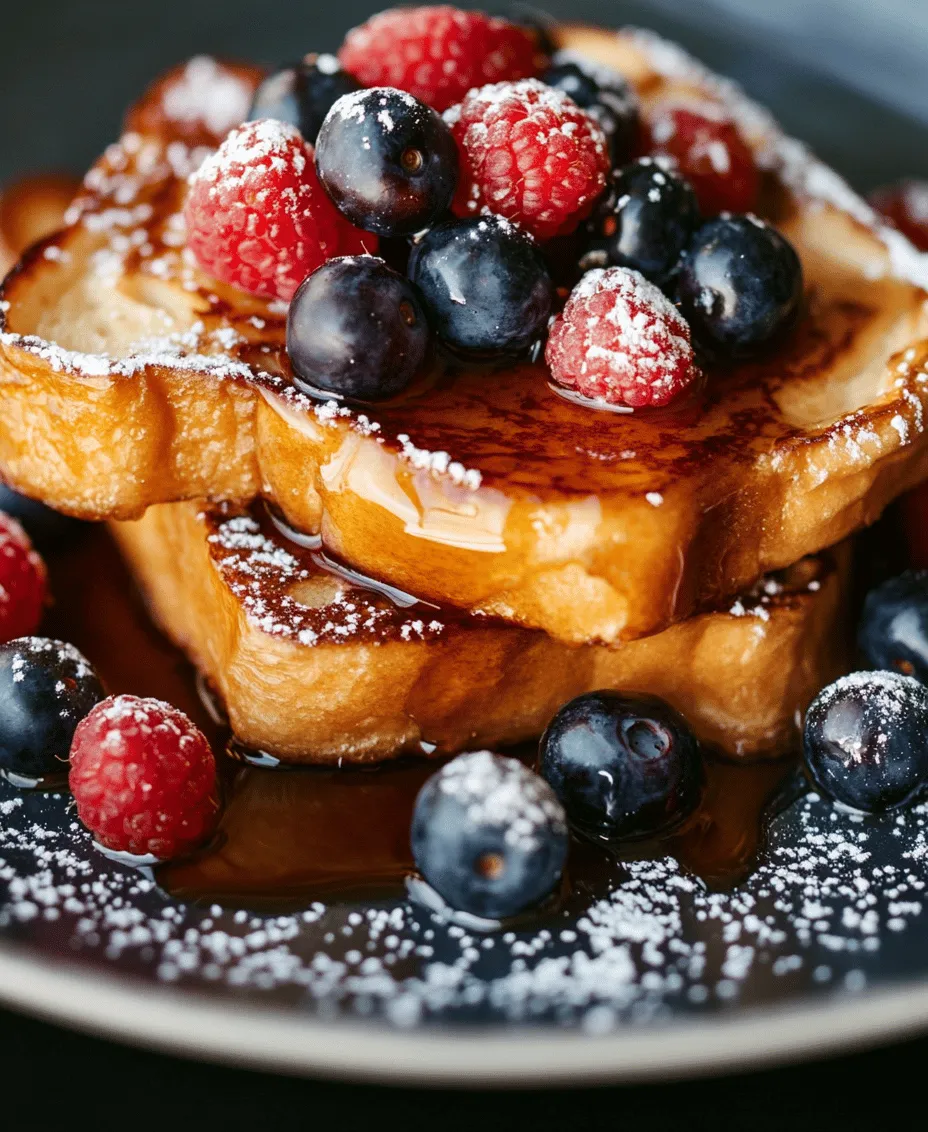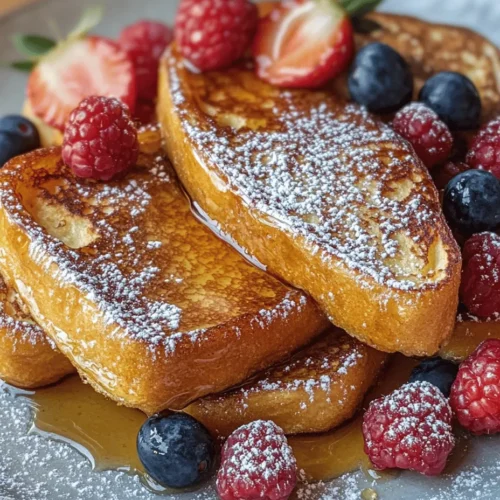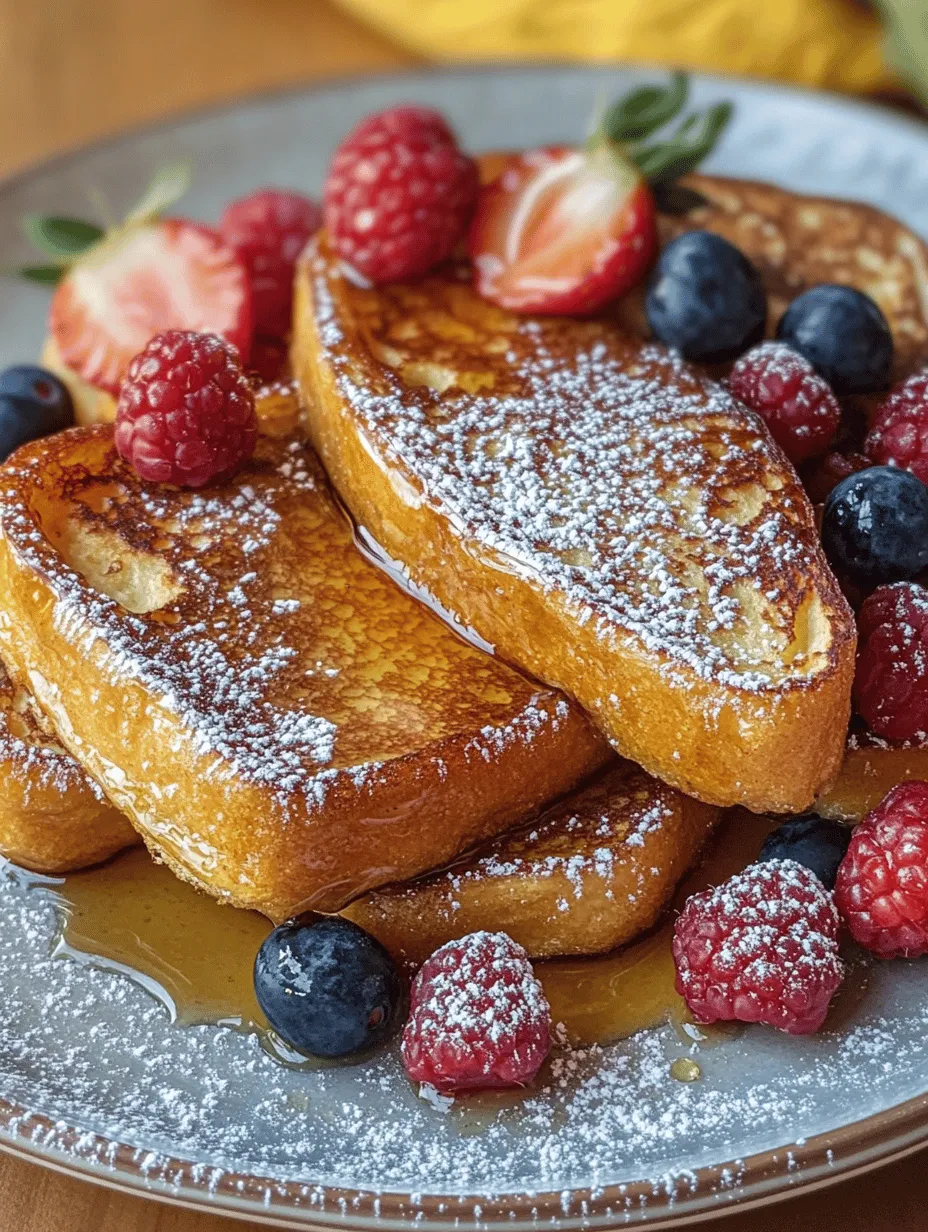Introduction
There’s something undeniably heartwarming about the aroma of freshly cooked French toast wafting through the house on a lazy weekend morning. This classic breakfast dish has a special place in the hearts of many, evoking memories of family gatherings, cozy brunches, and leisurely starts to the day. French toast, with its golden-brown exterior and soft, custardy interior, offers a delightful blend of flavors and textures that can be tailored to suit any palate—from the simplest version topped with a drizzle of maple syrup to extravagant variations garnished with fruits, whipped cream, or even a sprinkle of powdered sugar.
The beauty of French toast lies in its versatility. It can be a quick weekday breakfast or a lavish centerpiece for special gatherings, inviting friends and family to indulge in a morning feast. Whether you enjoy it plain, with fresh berries, or dressed up with decadent toppings, French toast is a dish that brings people together and sparks joy. It’s a cherished recipe that transcends generations, making it a perfect choice for anyone looking to create memorable moments around the breakfast table.
Understanding the Basics of French Toast
The origins of French toast date back centuries, with roots tracing back to ancient civilizations. Although the exact origin is debated, it is believed that the Romans were among the first to create a dish similar to what we now call French toast. They would soak bread in a mixture of milk and eggs, then fry it, creating a simple yet satisfying meal. As time progressed, various cultures adapted this concept, leading to a plethora of regional variations across the globe.
In France, it is known as “pain perdu,” which translates to “lost bread,” reflecting the dish’s humble beginnings. Traditionally, it was a way to rescue stale bread, transforming it into a delicious breakfast treat. Other cultures have embraced similar methods; for instance, in Spain, “torrijas” are made during Lent, while in the United States, fluffy slices of bread are often used to create a delightful morning meal.
This simplicity and adaptability make French toast a beloved staple in households worldwide. It requires minimal ingredients and kitchen equipment, allowing anyone—regardless of culinary skill—to whip up a delicious batch. All you need is some bread, eggs, milk, and a few flavor enhancers to create a delightful breakfast that can be enjoyed any day of the week.
Essential Ingredients for the Perfect French Toast
To create a Classic French Toast Delight that rivals your favorite brunch spot, it’s essential to select the right ingredients. Each component plays a crucial role in achieving the perfect texture and flavor.
Bread Selection
The foundation of any French toast lies in the choice of bread. While you can technically use any bread, some varieties yield better results than others. Here are a few popular options:
– Challah: This rich, eggy bread is a favorite for French toast. Its soft texture and slightly sweet flavor absorb the custard mixture beautifully, resulting in a decadent treat.
– Brioche: Another excellent choice, brioche is known for its buttery richness. The dense yet fluffy texture creates a satisfying bite, making it a perfect vehicle for the custard.
– Sourdough: For those who enjoy a tangy flavor, sourdough offers a unique twist. Its crusty exterior and chewy interior provide a delightful contrast to the soft custard.
– Texas Toast: Thick-cut bread, such as Texas toast, can also be used. Its heftiness ensures it stands up to the soaking process, resulting in a satisfying, sturdy slice.
Choosing the right bread not only impacts the texture but also enhances the overall flavor of your French toast. Consider experimenting with different types to find your perfect match!
Eggs and Dairy
The custard-like mixture that envelops the bread is the heart of French toast, and it relies heavily on eggs and dairy. Eggs serve multiple purposes: they provide structure, moisture, and richness. When whisked together with milk or cream, they create a silky batter that coats the bread, infusing it with flavor and moisture.
Using whole milk adds creaminess, while heavy cream can elevate the dish to a more indulgent level. For those looking for a lighter option, skim milk can also work, though it may yield a slightly less rich custard. Additionally, you can experiment with dairy alternatives, such as almond milk or oat milk, to accommodate dietary preferences or restrictions.
Flavor Enhancers
To take your French toast to the next level, incorporate flavor enhancers that will elevate the dish’s aroma and taste. Two classics are:
– Vanilla Extract: A splash of pure vanilla extract brings warmth and depth to the custard mixture. It complements the richness of the eggs and dairy, creating a harmonious flavor profile.
– Ground Cinnamon: This beloved spice adds a warm, comforting note to the dish. A sprinkle of cinnamon not only enhances the taste but also contributes to the inviting aroma that fills your kitchen while cooking.
Feel free to experiment with other spices or flavorings, such as nutmeg or citrus zest, to create a signature twist on this classic recipe.
Cooking Essentials
Finally, the cooking essentials play a significant role in achieving that coveted golden-brown crust. Butter is a must-have ingredient for cooking French toast. It adds richness and flavor while helping to create a beautifully caramelized exterior. For the best results, use unsalted butter, which allows you to control the seasoning.
In addition to butter, you might consider using a non-stick skillet or griddle for cooking. This helps to ensure even heat distribution and prevents sticking, allowing for a stress-free cooking experience.
Step-by-Step Instructions to Make Classic French Toast Delight
Now that you have a solid understanding of the essential ingredients, it’s time to dive into the cooking process. Follow these step-by-step instructions to create your own Classic French Toast Delight:
Preparing the Custard Mixture
1. Gather Your Ingredients: Begin by gathering all the necessary ingredients. You’ll need your chosen bread, eggs, milk, vanilla extract, and ground cinnamon.
2. Whisk the Eggs: In a large mixing bowl, crack the desired number of eggs—typically, two eggs will suffice for about four slices of bread. Use a whisk or fork to beat the eggs until they are well combined.
3. Add the Dairy: Pour in the milk or cream, depending on your preference for richness. A ratio of about 1/2 cup of milk per egg works well, but feel free to adjust according to your taste.
4. Incorporate Flavorings: Add a splash of pure vanilla extract and a generous sprinkle of ground cinnamon to the egg mixture. Whisk everything together until the ingredients are thoroughly combined, and the mixture is smooth and creamy.
5. Soak the Bread: Preheat your skillet or griddle over medium heat and add a pat of butter, allowing it to melt and coat the surface. Take a slice of your chosen bread and dip it into the custard mixture, ensuring both sides are well coated. Allow it to soak for a moment to absorb the flavors while preventing it from becoming too soggy.
6. Cook the French Toast: Once the skillet is ready, carefully place the soaked bread onto the hot surface. Cook for about 2-3 minutes on each side, or until the toast is golden brown and cooked through. Adjust the heat as needed to ensure even cooking without burning.
7. Repeat the Process: Continue the soaking and cooking process with the remaining slices of bread, adding more butter to the skillet as necessary.
By following these steps, you will create a delightful batch of Classic French Toast Delight that is sure to impress family and friends alike. The next part will delve into additional tips and tricks for perfecting your French toast experience, ensuring that each bite is as delicious as the last. Stay tuned for expert advice that will elevate your culinary skills and enhance your breakfast repertoire!

Cooking Techniques for Classic French Toast Delight
To achieve the perfect Classic French Toast, understanding cooking techniques is essential. Begin with the preheating of your skillet. This step is crucial as it ensures that the bread cooks evenly and develops that golden-brown hue without burning. A preheated skillet allows for a nice sear on the bread, providing a delightful crispiness on the outside while keeping the inside moist and fluffy.
When preheating, aim for medium heat. If the skillet is too hot, the exterior of the French toast will burn before the inside has had a chance to cook through. Conversely, if the skillet is too cool, the bread will soak up too much egg mixture, becoming soggy rather than fluffy. A good way to test your skillet’s readiness is to sprinkle a few drops of water onto the surface; if they dance and evaporate quickly, the skillet is ready for action.
Soaking the Bread
The soaking process is where the magic happens. Properly soaking the bread is key to achieving that classic texture that defines French toast. Aim for a soaking time of about 30 seconds to 1 minute per side. This allows the bread to absorb the egg mixture without becoming overly mushy. For denser breads like brioche or challah, you may want to extend the soaking time slightly, but always monitor the texture closely.
The goal is to have the bread absorb enough of the mixture to be flavorful and custardy without falling apart. After soaking, gently shake off any excess mixture to prevent sogginess. This balance is what makes every bite of French toast a delightful experience.
Cooking to Perfection
Once your bread is soaked and your skillet is ready, it’s time to cook the French toast. Carefully place the slices onto the skillet, ensuring not to overcrowd the pan, as this can lower the temperature and lead to uneven cooking. Cook each slice for about 2-3 minutes per side. You’re aiming for a beautiful golden hue and a slight crispiness on the outside.
Keep an eye on your toast while it cooks. If you notice the edges darkening too quickly, lower the heat slightly. This will help the interior cook through without burning the exterior. Once you’ve achieved that perfect golden color, it’s time to remove the French toast from the skillet and place it on a warm plate while you repeat the process for the remaining slices.
Serving Suggestions for a Memorable Breakfast Experience
When it comes to serving Classic French Toast Delight, the possibilities are endless. Presentation and customization can elevate your breakfast from ordinary to extraordinary.
Classic Toppings
The traditional topping for French toast is maple syrup, and for good reason. Its rich, sweet flavor complements the custardy bread perfectly, providing a classic taste that many adore. Drizzle warm maple syrup generously over your French toast, allowing it to seep into every crevice for maximum flavor.
Fresh Berries and Garnishes
Adding fresh berries not only enhances the flavor profile but also adds a vibrant pop of color to your plate. Strawberries, blueberries, raspberries, or even sliced bananas work wonderfully. The natural sweetness of the fruits balances the richness of the French toast while providing a refreshing contrast. For an elegant touch, consider garnishing with a sprig of mint or a dusting of powdered sugar to complete the presentation.
Optional Additions
For those who enjoy experimenting, consider adding whipped cream for a decadent touch or flavored syrups such as caramel or berry syrups for a unique twist. You can also incorporate nuts like sliced almonds or pecans for added crunch and flavor. For a more indulgent experience, serve with a dollop of cream cheese or mascarpone on the side, allowing guests to spread it on their toast as they like.
Nutritional Breakdown of Classic French Toast
As with any recipe, being aware of the nutritional content can help you make informed choices, especially for those who are mindful of their diet.
Caloric Content
On average, a serving of Classic French Toast (which typically consists of two slices) can contain around 300-400 calories, depending on the type of bread used and the amount of toppings added. For those watching their caloric intake, consider using whole grain bread, which can add fiber, making it a more filling option.
Balance of Ingredients
The combination of eggs, milk, and bread in this recipe offers a balance of carbohydrates and protein, making it a satisfying breakfast choice. The addition of toppings like fruits can introduce vitamins and antioxidants, enhancing the nutritional profile. While French toast can be indulgent, modifying the ingredients and toppings can create a more balanced meal suitable for breakfast or brunch.
Conclusion
Classic French Toast Delight is more than just a breakfast dish; it is a cherished experience that brings comfort and joy to many. With its versatile nature, this recipe allows for endless customization, ensuring that every plate can be uniquely tailored to personal tastes. Whether you prefer classic maple syrup or adventurous toppings, this dish is sure to satisfy.
As you embark on your journey to make French toast, remember that the joy of cooking comes not just from the end product, but also from the experience of preparing it. Share your own variations and experiences with friends and family, and foster a sense of community around this beloved breakfast staple. Enjoy every bite, and let Classic French Toast Delight become a favorite in your household, perfect for any day of the week!



